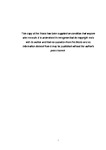A study of the dissolution of atmospherically derived trace metals into North Atlantic seawater
| dc.contributor.supervisor | Ussher, Simon | |
| dc.contributor.author | Fishwick, Matthew Paul | |
| dc.contributor.other | School of Geography, Earth and Environmental Sciences | en_US |
| dc.date.accessioned | 2016-08-12T12:52:36Z | |
| dc.date.available | 2016-08-12T12:52:36Z | |
| dc.date.issued | 2016 | |
| dc.identifier | 758378 | en_US |
| dc.identifier.uri | http://hdl.handle.net/10026.1/5288 | |
| dc.description | Chapter 3 has been used to create a manuscript, which was published in Global Biogeochemical Cycles in 2014, see reference: Fishwick, M. P., P. N. Sedwick, M. C. Lohan, P. J. Worsfold, K. N. Buck, T. M. Church, and S. J. Ussher (2014), The impact of changing surface ocean conditions on the dissolution of aerosol iron, Global Biogeochemical Cycles, 28, doi:10.1002/2014GB004921. Chapters 4 and 5 are currently being used to create manuscripts for publication. | en_US |
| dc.description.abstract |
The aim of this study was to investigate the factors that affect the dissolution of a suite of trace metals from aerosols into seawater from wet and dry deposition, with a focus on important trace metals: manganese (Mn), iron (Fe), cobalt (Co), nickel (Ni), copper (Cu) and lead (Pb). To this end, aerosol and rainwater samples were collected from Tudor Hill (Bermuda) and Penlee Point (Cornwall) atmospheric observatories and surface seawater samples were collected from the Sargasso Sea and the Celtic Sea. These representative aerosol, rainwater and seawater samples were used in aerosol leaching and rainwater mixing experiments, which simulated the processes of mixing and trace metal dissolution following wet and dry deposition as closely as possible within the laboratory. Key variables were changed to investigate the effect of aerosol source/composition, seawater temperature, pH, dissolved oxygen concentration and organic ligand amendments on aerosol and rainwater trace metal dissolution. Results for aerosol leaching experiments revealed that changes to key physico-chemical conditions had little effect on the amount of Mn, Fe, Co, Ni and Pb leached from aerosols and therefore plausible future changes in ocean surface temperature, pH and oxygenation are unlikely to affect the flux of these important trace metals to surface waters. Conversely, aerosol source and composition had a significant effect on the dissolution of aerosol Fe, Co and Pb, with the most anthropogenically influenced aerosol samples displaying the highest solubilities. Therefore, future changes in land use and fossil fuel combustion are likely to affect the flux of these metals to the surface ocean. Fractional solubilities were in the range of 50 – 104% for Mn, 0.3 – 3.2% for Fe, 29 – 58% for Co, 40 – 85% for Ni and 67 – 112% for Pb. In addition, novel empirical relationships were found between the fractional solubilities of Fe, Co and Pb and enrichment factors for antimony, vanadium, Ni and Cu. This suggests that these fractional solubilities in seawater could be predicted using only total aerosol trace metal concentrations. The use of ultrafiltration provided unique insight into the size fractionation (colloidal 0.02 – 0.4 μm; soluble < 0.02 μm) of dissolved aerosol trace metals and showed Fe and Pb were mostly colloidal (77 – 98% colloidal), Mn and Co were mostly soluble (0 – 48% colloidal) and Ni showed a mixed profile (6 – 58% colloidal) when released from aerosols into ambient seawater. However, in the presence of a sufficient concentration of strong organic ligands the majority colloidal Fe was converted to soluble Fe (up to 100% soluble). Some of these organic ligands were also able to increase the soluble fraction of dissolved aerosol Mn. Similarly, the presence of organic ligands in rainwater maintained Mn, Fe, Co, Cu and Pb in the dissolved phase following delivery by rain into seawater. Rainwater ligands had no effect on the typically varied size fractionation profile of Mn, Fe, Co and Cu in rainwater mixed with seawater, UV-irradiation of rainwater, however, shifted the size fractionation of Pb in rainwater/seawater mixtures from 80 – 100% colloidal to 13 – 63% soluble, indicating that Pb-binding rainwater ligands are either colloidal or attached to colloidal matter. These findings highlight the importance of organic ligands in rainwater and seawater for retaining trace metal micronutrients and toxicants in the surface ocean, with implications for primary production. | en_US |
| dc.description.sponsorship | Natural Environment Research Council (NERC) | en_US |
| dc.language.iso | en | en_US |
| dc.publisher | Plymouth University | en_US |
| dc.subject | Biogeochemistry | en_US |
| dc.subject | Trace metals | en_US |
| dc.subject | Iron | en_US |
| dc.subject | Aerosols | en_US |
| dc.subject | Dissolution | en_US |
| dc.subject | Global environmental change | en_US |
| dc.subject | Organic ligands | en_US |
| dc.title | A study of the dissolution of atmospherically derived trace metals into North Atlantic seawater | en_US |
| dc.type | Thesis | |
| plymouth.version | Full version | en_US |
| dc.identifier.doi | http://dx.doi.org/10.24382/4313 |
Files in this item
This item appears in the following Collection(s)
-
01 Research Theses Main Collection
Research Theses Main


